ISSN ONLINE(2320-9801) PRINT (2320-9798)
ISSN ONLINE(2320-9801) PRINT (2320-9798)
S.Jasmine Vanitha1, K. Manimozhi2
|
| Related article at Pubmed, Scholar Google |
Visit for more related articles at International Journal of Innovative Research in Computer and Communication Engineering
This paper provides an innovative form of ―Translation of unintelligible speech of user into synthetic speech using augmentative and alternative communication (AAC) device‖. This AAC device converts the meaningless speech into understandable speech .The development of this system is carried out by building small vocabulary from both the utterance and from the inaudible speech of the autism people. Experiments showed that this method is successful in generating good recognition and translation performance on highly unintelligible speech, even when recognition perplexity is increased.
Keywords |
| Augmentative and alternative communication, Automatic voice recognition, autism, interpret. |
INTRODUCTION |
| Consider a world without a sound, a world where we cannot tell someone what we want or a world where we cannot get the feedback for what we are doing, it is impossible to survive in that situation. The similar feelings are felt by the people who have unintelligible .Since the speech of autism is not understand by relatives or neighbours. In order to solve this problem automatic speech recognition was introduced. In prevailing methods of recognition system, the people used mouse, keyboard as input to deliver their messages to their relatives and neighbour. But that method was inconvenient to autism as they prefer to speak rather than an aid. Thereby the objective of this paper is to introduce such a recognition system.The augmentative and alternative communication device is used as a mediator between the autism and their relative. This device translates the unintelligible speech of the user into a synthetic speech. The AAC device is divided into two types. One is aided technique and second one is unaided technique. In aided technique, there are two types. They are low tech and high tech.LOW TECH- The pictures, shapes, numbers are used to convey the messages. HIGH TECH- The electronic instruments are used to convey their messages to relatives.In unaided technique, the autism uses their hands and makes gesture to convey their messages. Therefore the unaided technique used for people without the speaking ability. |
II. RELATED WORKS |
| Many development systems in surviving method use independent speech recognition system. The independent system can recognize any speech of the user and thus these models are trained on large corpus data recorded by many speakers. The capability of recognition in independent system is less as many speakers use the same system. The resultant output is also not accurate and satisfied. And this independent automatic speech recognition system is unsuitable for speaker with severe speech disorders because the amount of material available for training is severely limited (as speaking often requires great effort), the material is highly variable, often has a limited phonetic repertoire, and is too different from the normal speech used in training speaker independent models for many conventional adaptation techniques to be of assistance. Hence a new methodology of dependentspeech recognition system is introduced to make the resultant output accurate and satisfied. |
| The projected system overcomes the disadvantages of surviving methods by using the dependent speech recognition system. The projected system is suitable for two types of users. One is the user with partially speaking ability and another one is the speaker without speaking ability. And if any emergency situation occurs to the partially speaking user, an alert message is generated and sent to the number which is already saved. The partially speaking user uses the high tech of the aided system in augmentative and alternative communication device. The speaker without speaking ability uses the unaided technique in augmentative and alternative communication device. |
III. MAIN CONCEPT OF THE PAPER |
| The recognition system in this paper supports two kinds of users that are it supports both the autism people and dumb people. The autism person has a partially speaking ability so the process of conveying their message plays a very difficult role. Consequently to make the task easier speech recognition IC and speaker module are used.The speech recognition IC recognize the speech input from the user through the microphone and this recognized unintelligible speech of the user is translated into synthetic speech using the speaker module. Finally the output of partially speaking user is delivered by speaker and LCD display. |
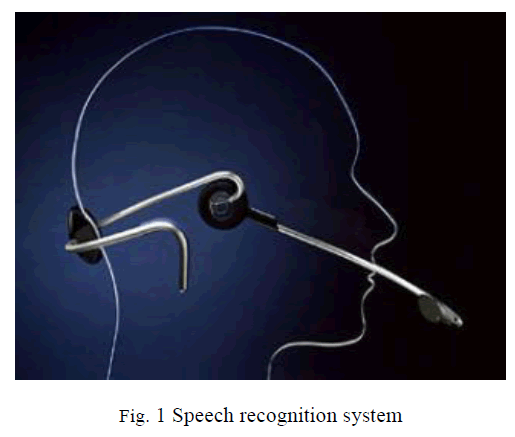 |
| In addition to autism person the recognition system also supports the people without speaking ability. For that reason they use action to convey their message to their relatives. The process of recognizing the action is performed by the sensor and this message is translated into a speech using the speaker module. Finally the output is delivered through the speaker.In addition to this, if any emergency situation occurs for partially speaking user an alert message is engendered and directed to the mobile number which is already stowed. The alert message is delivered to the number using the AT commands. |
IV. PROPOSED SYTEM |
| The words spoken by human being causes some vibration in air known as sound waves. These sound waves are continuous or analog signal are translated into electrical signal by microphone. HM2007 is recognition IC and it performs two functions. One is training the words and other one is clearing the trained words. For both functions keypad is used to save word with corresponding number.For example: Press âÃâ¬Ãâ¢1âÃâ¬Ãâ (display will show âÃâ¬Ãâ¢01âÃâ¬Ãâ and the LED will turn off) on the keypad, then press the TRAIN key (The LED will turn on) to place circuit in training mode, for word one. Say the target word into the on-board microphone (near LED) clearly. The circuit signals acceptance of the voice input by blinking the LED off then on. The word (or utterance) is now identified as the âÃâ¬Ãâ¢01âÃâ¬Ãâ word. If the LED did not flash, start over by pressing âÃâ¬Ãâ¢1âÃâ¬Ãâ and then âÃâ¬Ãâ¢TRAINâÃâ¬Ãâ key. |
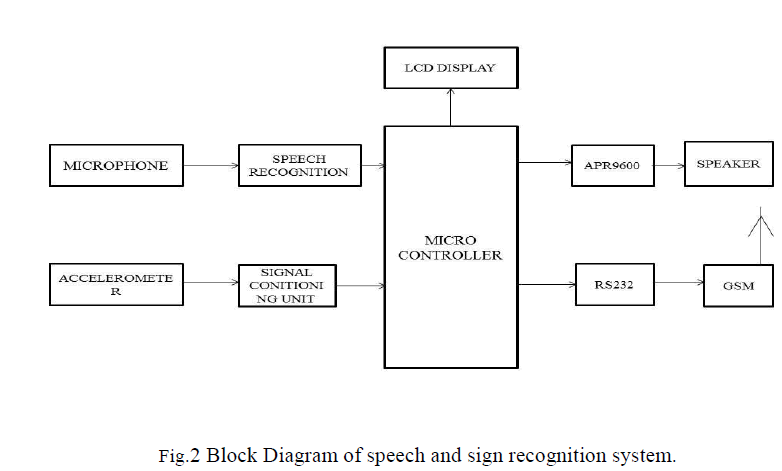 |
| Testing Recognition: Repeat a trained word into the microphone. The number of the word should be displayed on the digital display. For instance, if the word âÃâ¬Ãâ¢directoryâÃâ¬Ãâ was trained as word number 20, saying theword âÃâ¬Ãâ¢directoryâÃâ¬Ãâ into the microphone will cause the number 20 to be displayed.The peripherals are controlled by the microcontroller. The microcontroller sends the input of partially speaking user from HM2007 to speaker module. This module operates as a recording and playback system. The each words spoken by partially speaking user has a corresponding phrase which is already stored in the speaker module. Hence the phrase is engendered for corresponding input.For example: In training mode, number 1 is pressed and an input âÃâ¬Ãâ¢drink teaâÃâ¬Ãâ is given. For that corresponding 1 input a phrase âÃâ¬Ãâ¢can I have a teaâÃâ¬Ãâ is trained in APR module. In recognition mode when the user says the word âÃâ¬Ãâ¢drink teaâÃâ¬Ãâ then automatically the phrase âÃâ¬Ãâ¢can I have a teaâÃâ¬Ãâ is played out by loudspeaker. |
| An accelerometer is an electromechanical device that will measure acceleration forces. These forces may be static, like the constant force of gravity pulling at your feet, or they could be dynamic - caused by moving or vibrating the accelerometer. An accelerometer is a device that measures the vibration, or acceleration of motion of a structure. The force caused by vibration or a change in motion (acceleration) causes the mass to "squeeze" the piezoelectric material which produces an electrical charge that is proportional to the force exerted upon it. Since the charge is proportional to the force, and the mass is a constant, then the charge is also proportional to the acceleration. The piezoelectric crystal produces an electrical charge which is connected directly to the measurement instruments. The charge output requires special accommodations and instrumentation most commonly found in research facilities. This type of accelerometer is also used in high temperature applications (>120C) where low impedance models cannot be used.Triaxial accelerometers measure the vibration in three axes X, Y and Z. They have three crystals positioned so that each one reacts to vibration in a different axis. The output has three signals, each representing the vibration for one of the three axes. |
V. SIMULATION RESULTS |
| The software result is obtained for two operation modes. One is the emergency situation of partially speaking user and another one is normal situation of partially speaking user.Fig.3 shows the entire view of simulation result. In that image the two switches are used as an input which designate the operation modes. The first switch gives the emergency operation mode and the switch below is responsible for normal operation mode of partially speaking user. |
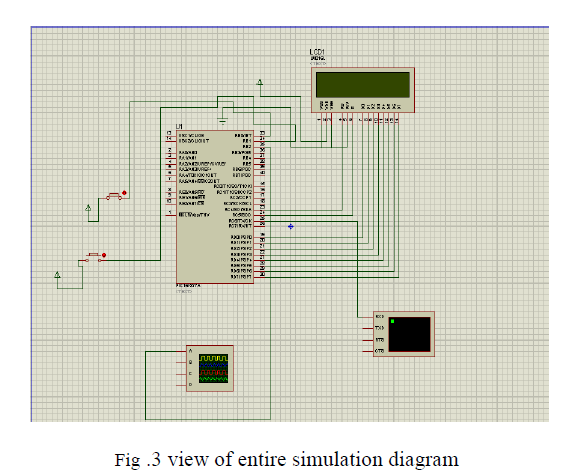 |
| The minute the first switch is pressed, the input from the user is given to pic microcontroller. The controller then checks whether the input matches emergency situation message. If it counterparts the condition it display the message in LCD display and also gives an alert message to already kept number using AT commands. This result is shown in fig 4. |
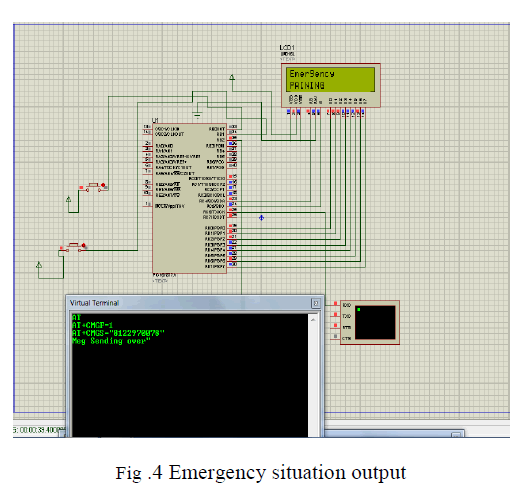 |
| The Fig 5 shows the output of partially speaking user. This operation is designated by pressing the lower switch. As soon as the switch is pushed the input is given to microcontroller. The LCD display the input controlled by microcontroller if the messages matches with trained words. And consequently the signal is asserted high in the oscilloscope signifying an acceptance of the input. If the switch is released then signal becomes low in oscilloscope. |
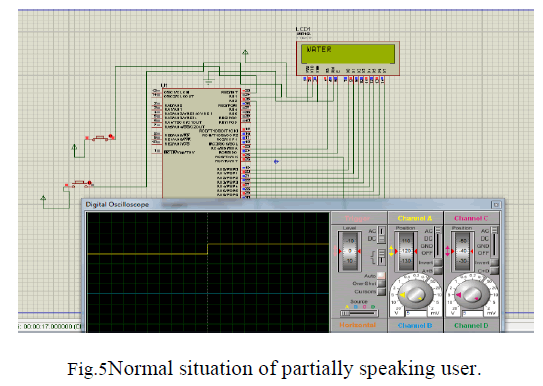 |
VI. CONCLUSION |
| Thus the paper âÃâ¬Ãâ¢Translation of unintelligible speech of user into synthetic speech using augmentative and alternative communication deviceâÃâ¬Ãâ solves the problem of people who have great difficulty to speak with people. Additionally it also resolves the difficult of dumb people. The enhancement of the system can be made for user without speaking ability. A sixth sense technology can be engenderedpredominantlyfor dumb people to satisfy their requirements rapidly. And further development should concentrate on storage of trained words so that the number of trained words can be increased. |
References |
|